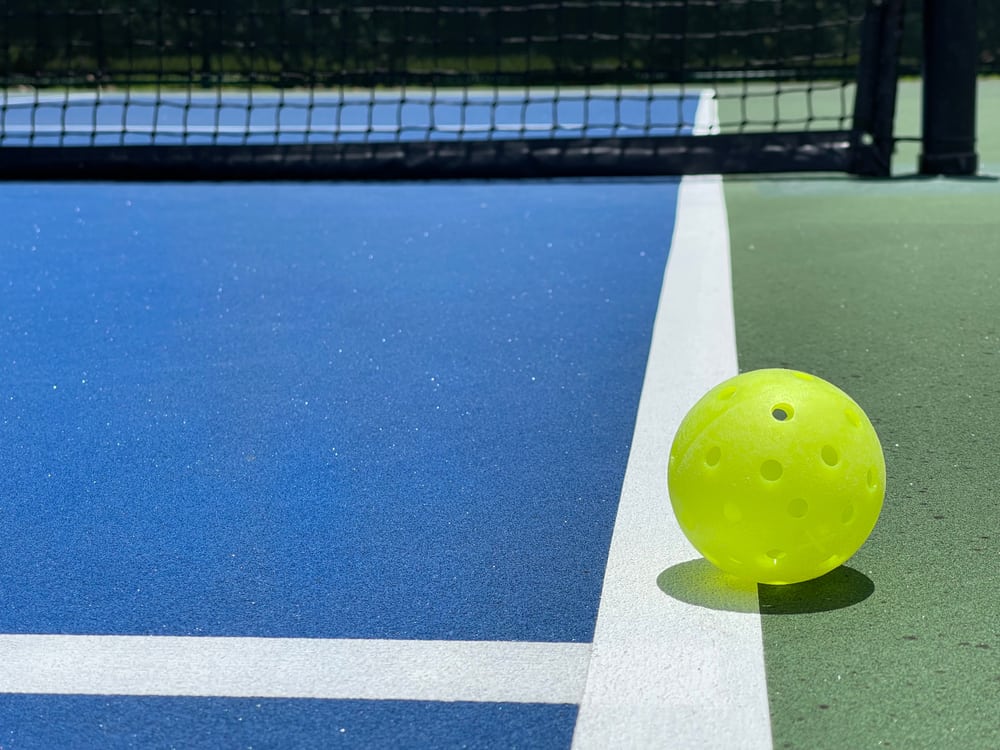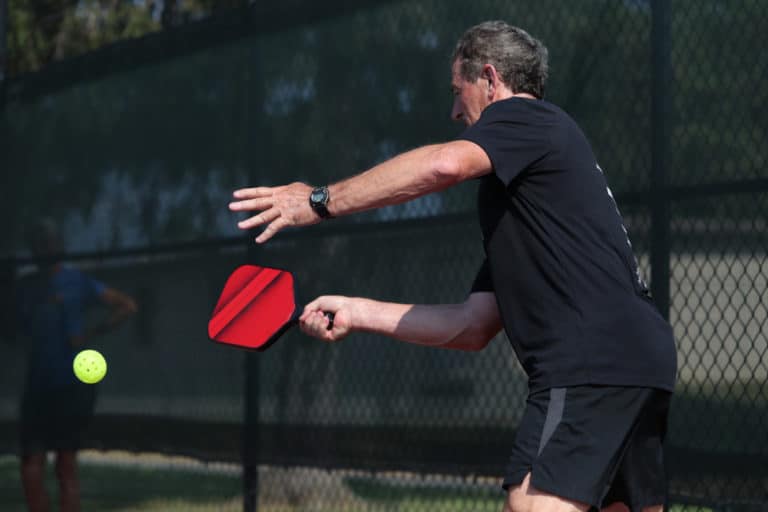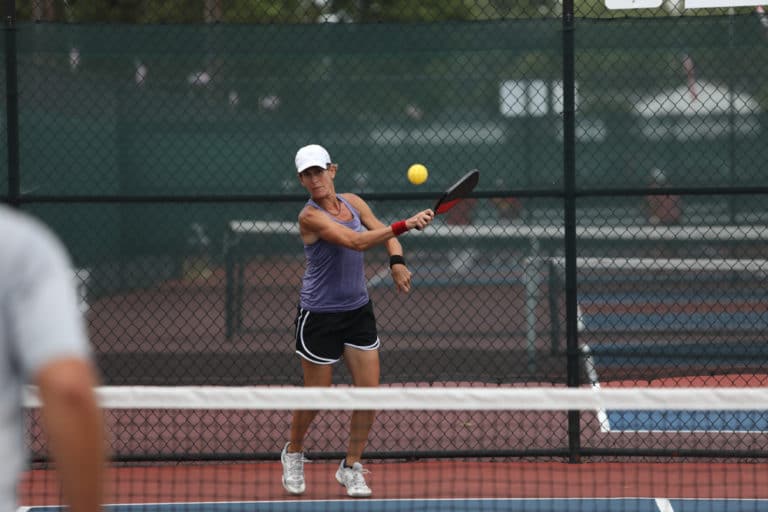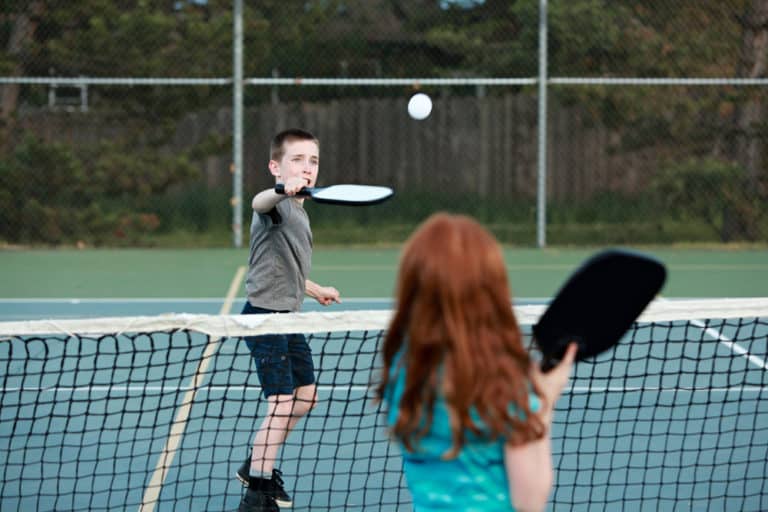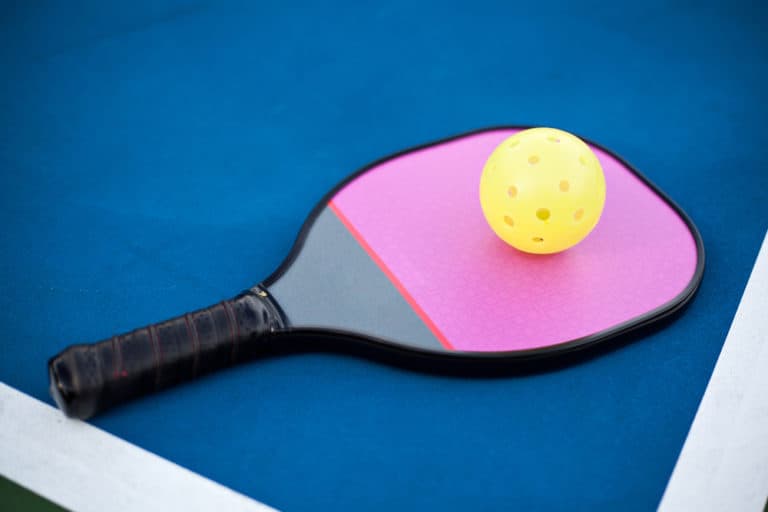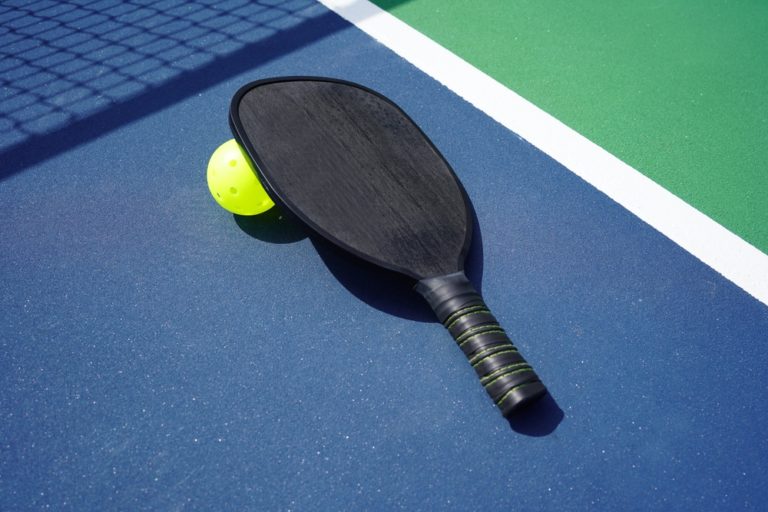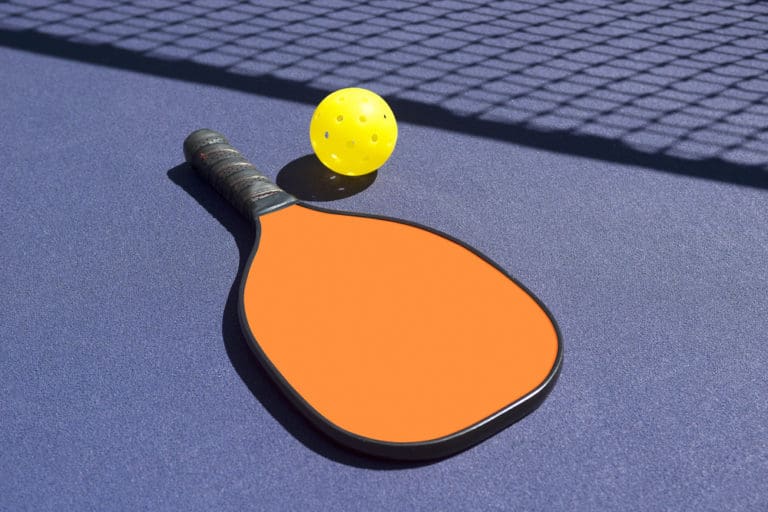How Long Do Pickleball Balls Last?
Pickleball is as exciting as it is entertaining! I play at least four times a week, but sometimes I can spend varying amounts on pickleball balls. Some might say they go through two balls a game, while others double that, so what gives? How long do pickleball balls last?
Pickleball balls last anywhere from a few games to a few weeks or even months. Indoor and outdoor pickleball balls don’t have the same lifespan. Pickleball brand, player’s playstyle, temperature, and asphalt, concrete, or gymnasium wood surfaces contribute to the lifespan of a pickleball ball.
Knowing what causes your pickleball balls to wear down can help you make better choices next time you have a bag loaded into your shopping cart. Let’s explore their composition, look at some brands and why they last longer, and what happens on the court that diminish the playability of your favorite pickleball ball.
How Long Do Pickleball Balls Last?
A pickleball ball can last a few days, weeks, or even months. In truth, your ball may last longer than your neighbors because first, second, and third-party effects come into play!
What Affects The Lifespan Of A Pickleball Ball?
Firstly, remember that a pickleball ball can be either an outdoor ball or an indoor ball. Although they both have a plastic construction, they react differently to their playing surface. Outdoor pickleball balls need to be harder because they make frequent asphalt or concrete surfaces. Indoor balls, however, are softer because they typically make contact with wood surfaces.
Furthermore, players also affect how long a pickleball ball lasts by their playstyle and how hard they swing their paddle. Those who enjoy rallies near the kitchen will make more frequent paddle-to-paddle, often hitting hard to catch their opposition off-guard. Consequently, the ball receives more of a beating and wears out quickly.
How Long Do Outdoor Pickleball Balls last?
Outdoor pickleball courts are usually tennis courts lined for pickleball or pickleball-specific courts. They have an asphalt or concrete surface, and the ball reacts differently than on an indoor court.
Outdoor pickleball balls are smaller holes, and their plastic compound is significantly tougher. As a result, getting hit anywhere on your body with an outdoor pickleball ball hurts more than an indoor ball. One of the most important reasons for these characteristics, particularly the number and size of their holes, is that they must be able to withstand windy weather conditions.
Small holes prevent an excessive amount of wind from entering the ball, allowing the ball to travel at a smoother trajectory through the air.
Although it is permissible to use an outdoor ball indoors and vice-versa, doing so will affect how long the ball lasts. You will notice the ball easily forms cracks, becomes smoother much faster, and become undesirable. Since indoor balls have softer plastics, repeated knocks against harder asphalt or concrete surface will most certainly guarantee that the plastic wears quicker.
What Are The Tell-Tale Signs Of A Worn Outdoor Ball?
When you spend a lot of time playing with the same ball, it will start to wear down and form a different shape. More specifically, it will begin to take the shape of an egg, where one side starts to squish while the other side becomes more protruding (also known as egging).
Playing consistently with an “egged ball” will weaken it in the middle and cause it to crack or break without warning. That said, it’s also normal for some pickleball balls to break before others.
When a pickleball ball starts to wear, the hard plastic becomes softer, meaning that you can’t hit it as hard as you previously did. Consequently, it alters how the ball feels when it makes contact with your paddle and how it travels across the court. Additionally, a softer ball also removes some of the skills required to perform certain shots successfully.
Not All Pickleball Balls Are The Same
The price tag of a pickleball ball does not always equate to its overall lifespan. There are numerous pickleball ball manufacturers, and they each tailor their ball to specialize in either spin, durability, control, or speed. In other words, it shouldn’t surprise you when a five-dollar ball lasts twice as long as a ten-dollar ball.
Dura Fast 40 Outdoor Ball
For example, Dura Fast 40 balls tend to break relatively quickly, despite their name deriving from “durable.” It’s not a scheme to get you to buy more balls, but rather that their balls focus on providing a fast-paced, adrenaline-inducing pickleball experience.
As any pickleball ball wears, it becomes softer. Eventually, it will start to feel like you’re hitting a mushed orange, and that’s where certain brands like Dura Fast 40 shine. Before the ball softens to the point where it becomes a nightmare, it will crack as a sign that it’s time for a new one.
These tell-tale signs are not always obvious, but it is one of the reasons why certain brands are more popular than others. If you consider the Onyx Fuse Outdoor ball, it does not crack nearly as quickly as the Dura Fast 40, but it’s also much more inexpensive.
Consequently, beginners can get away with the Onyx Fuse Outdoor ball because it will last them much longer. However, be mindful that it will change the way the game plays, which is another reason why most top-level players highly respect the Dura Fast 40.
Franklin Outdoor Ball
Franklin pickleball balls tend to be in the middle; they’re not as soft as the Onyx Fuse balls but not as hard as the Dura Fast 40. A Franklin ball will become softer quicker than most other pickleball balls, yet it will guarantee a longer lifespan.
Generally, the three most popular outdoor pickleball balls are the Onyx Fuse on the one end, Franklin in the middle, and Dura Fast 40 at the far end. Dura Fast 40 has the highest price tag but the lowest life span, whereas the Onyx Fuse is the least expensive and the most value-for-money alternative.
As a result, the Onyx Fuse is an excellent alternative for beginners, but if you’re a serious player, then the Franklin or Dura Fast 40 might have more potential.
How Long Do Indoor Pickleball Balls last?
Indoor pickleball courts are usually wooden basketball or gymnasium floors lined to make it possible to play pickleball. The ball reacts pretty differently to the wooden surface than asphalt or concrete.
Indoor balls have fewer, larger holes, and the plastic compound is softer because it does not need to make contact with harsh asphalt or concrete. Furthermore, it doesn’t require innate wind resistance for players to use it successfully.
It’s possible to play indoor pickleball with an outside ball, but it may not provide your optimum performance. Furthermore, softer pickleball balls will show earlier signs of cracking wear with players who enjoy making power shots, but they will last much longer with meticulous players that prefer a slower game.
The number one choice for outdoor competitive play tends to be the Dura Fast 40 balls because of their impressive speed.
What Are The Tell-Tale Signs Of A Worn Indoor Ball?
When it comes to gymnasium surfaces, you’ll find that the ball can bounce really high at times. Of course, it does not sit well with competitive players because if the ball bounces high on your opponent’s side, it means they have a steeper angle to deliver a good shot. Thus, players beat new balls against walls to make them softer so they would have lower bounce potential.
Among the best indoor balls is the Juggs Balls. They are right up there with the softest balls available, and although they don’t travel quickly, they last a very long time. Eventually, it will show signs of cracking to indicate you need to change over to a new ball!
The Onyx Fuse is the ball of choice for indoor competitive play due to its soft qualities that provide a lower bounce.
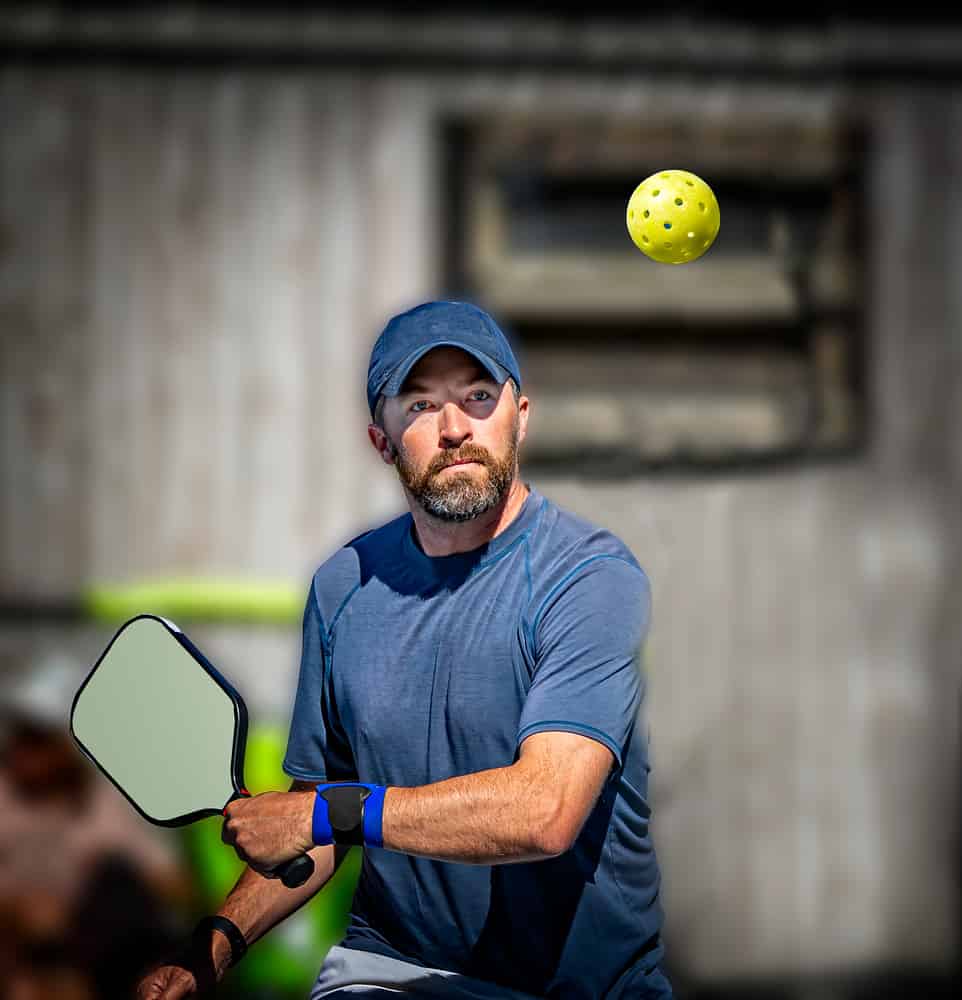
How Often Should You Replace Your Pickleball Ball?
The best way to know when it’s time for a new ball is to understand the tell-tale signs of a worn-out pickleball ball.
How Do You Know When A Pickleball Ball Is Bad?
When you consistently play with the same ball, it’s usually easy to spot inconsistencies as they rear their heads, but what if you change up the ball?
Fortunately, USAPA (USA Pickleball Association), the leading authority on all-things pickleball, including ball specifications, outlines specific criteria to make spotting a bad ball easier.
USAPA Ball Specifications
According to the USAPA, a ball’s design must have at least 26 circular holes with a maximum of 40 holes. The spacing and number of holes make for a well-balanced ball with proper airborne characteristics. Furthermore, every ball must have a supplier’s or manufacturer’s name or logo on the ball’s surface. While a logo doesn’t affect performance, it does guarantee a quality ball.
Further ball specifications include the following in terms of weight, bounce, and hardness:
- The total weight may not be lighter than 0.78 ounces and not heavier than 0.935 ounces.
- If you drop the pickleball ball from a height of 78 inches, it must have a bouncing height of between 30 and 34 inches.
- It must measure between 40 and 50 on the Durometer – specifically the D-scale that measures semi-rigid and hard plastics.
A good quality ball must consist of a durable material with a smooth surface without texturing. It cannot be multi-colored, except for markers on the ball that may help the player identify it. Additionally, it can have a tiny ridge at the seam, granted it does not affect the ball’s momentum or airborne characteristics during flight.
Essentially, a cracked ball will have an inefficient bounce and may not travel as far due, particularly when the holes are affected. Furthermore, you may also notice the ball becomes less bouncy the more you use it, and the pop from your paddle may not produce the same result as previous times.
Can Pickleball Balls Lose Their Bounce?
Pickleball balls consist of a hard-plastic construction that will eventually wear down when it comes into contact with opposing forces (like your paddle or the pickleball court). During this process, the plastic’s attributes become weaker and therefore incapable of delivering the same level of bounce and reliability as before – akin to how humans don’t run as fast when we age.
Furthermore, it can take a couple of weeks or even longer for a ball to lose its bounce entirely; harder hits on a tougher surface will wear a ball quicker.
In terms of appearance, a worn ball will have a much smoother surface in the same way that the tread of a car’s tire wears down after a few thousand miles.
How Does Weather Affect A Pickleball Ball?
Would you believe that professional athletes consider the climate of their match to improve their chances of success?
Heat tends to loosen the molecules in plastic and make it softer, while cold does the opposite and compresses them to make it harder. Since pickleball balls consist of a plastic compound, they do not remain unaffected by the temperature, and smart players will consider this when planning their next shot.
When you place a warm cup of hot chocolate in a cold piece of glass, there’s a good chance that the glass will crack or become brittle. In the same way, when you play pickleball in cold weather and with a soft ball, the cold will cause the ball to become harder.
As the ball continuously hardens and softens, it will weaken the molecular structure of the ball and cause it to crack more easily.
The same is also true for a hard ball; when you use a harder ball in water climates, it will soften more quickly and cause its molecules to come apart. As the temperature cools, the molecules come together again. Repeating this process will weaken the ball and make it more susceptible to cracks and bending out of shape.
Furthermore, colder weather also causes the ball to bounce more unexpectedly since it has a harder and more protruding surface area. Softer balls are a bit flatter on the surface and are thus more predictable in their bouncing and hitting patterns.
They understand that balls act differently in colder weather than in warmer weather. For example, football teams playing in freezing weather often have to compensate because footballs will bounce differently, especially when kicked.
Conclusion
Indoor pickleball balls usually last longer because they don’t need to fight against weather elements, make contact with a wooden gymnasium floor, and are softer. Outdoor balls crack quicker because they frequent a harsh asphalt surface, and they have the wind knocking them while the sun beats on them.
Sources
- https://www.reddit.com/r/Pickleball/comments/6kqk6s/how_long_do_outdoor_pickleballs_last/
- https://usapickleball.org/docs/ifp/USA-Pickleball-Rulebook.pdf
- https://www.pickleballrush.com/how-to-play-pickleball/equipment-specifications/ball
- https://pickleball.land/pickleball-balls-ultimate-guide/#:~:text=Official%20Pickleball%20Ball%20Rules&text=The%20ball%20must%20weigh%20between,40%20evenly%20spaced%2C%20circular%20holes.
- https://pickleballkitchen.com/pickleballs/#:~:text=One%20important%20aspect%20to%20remember,you%20can%20do%20about%20it.
- https://www.youtube.com/watch?v=FfWptjk87VQ&ab_channel=PickleballKitchen
- https://www.thedinkpickleball.com/zane/#:~:text=bit%20more%20patient.-,Temperature,the%20court%2C%20or%20somebody’s%20thigh
- https://www.wonderopolis.org/wonder/does-temperature-affect-the-bounce-of-a-ball

